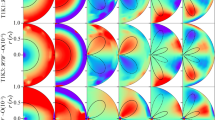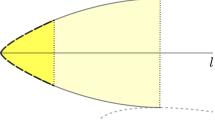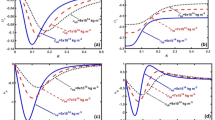Abstract
Interest in rapidly rotating neutron stars has been reinforced by the discovery of the fast pulsar PSR1937 + 214 (ref. 1). Here we report results of the first numerical construction of rapidly rotating relativistic stars based on equations of state (EOS) proposed for neutron-star matter. Of nine EOS considered, none permits uniformly rotating equilibrium configurations for which the ratio T/W of rotational energy to gravitational energy exceeds 0.12. Thus whereas a rotating neutron star spun up by accretion or formed by collapse of a rapidly rotating dwarf can be unstable2–7 to modes with angular dependence eimΦ for m = 3 or 4, instability to a bar mode (m = 2) appears very unlikely. For the stiffest EOS and for stellar masses near the Chandrasekhar mass (baryon mass M0 ≈ 1.4 M⊙), the upper limiting rotational frequencies imposed by the m = 3 or m = 4 instability are approximately equal to the frequency of the fast pulsar; for the softer EOS, the corresponding limiting frequencies are significantly larger. Uniform rotation increases the maximum gravitational mass of a model by an amount ranging from ∼14% for the softest models to ∼30% for the stiffest models.
This is a preview of subscription content, access via your institution
Access options
Subscribe to this journal
Receive 51 print issues and online access
$199.00 per year
only $3.90 per issue
Buy this article
- Purchase on Springer Link
- Instant access to full article PDF
Prices may be subject to local taxes which are calculated during checkout
Similar content being viewed by others
References
Backer, D. C., Kulkarni, S. R., Heiles, C., Davis, M. M. & Goss, W. M. Nature 300, 615–618 (1982).
Papaloizou, J. & Pringle, J. E. Mon. Not. R. astr. Soc. 184, 501–508 (1978).
Wagoner, R. V. Astrophys. J. 278, 345–348 (1984).
Friedman, J. L. Phys. Rev. Lett. 51, 11–14 (1983).
Harding, A. K. Nature 303, 683–684 (1983).
Ray, A. & Chitre, S. M. Nature 303, 409–410 (1983).
Cowsik, R., Ghosh, P. & Melvin, M. A. Nature 303, 308–310 (1983).
Hartle, J. B. & Thorne, K. S. Astrophys. J. 153, 807–834 (1968).
Bardeen, J. M. & Wagoner, R. V. Astrophys. J. 167, 359–423 (1971).
Wilson, J. R. Astrophys. J. 176, 195–204 (1972).
Bonazzola, S. & Schneider, J. Astrophys. J. 191, 273–285 (1974).
Butterworth, E. M. & Ipser, J. R. Astrophys. J. 204, 200–223 (1976).
Butterworth, E. M. Astrophys. J. 204, 561–572 (1976).
Arnett, W. D. & Bowers, R. L. Astrophys. J. Suppl. 33, 415–436 (1977).
Pandharipande, V. & Smith, R. A. Nucl. Phys. A 237, 507–532 (1975).
Walecka, J. D. Ann. Phys. 83, 491–529 (1974).
Bowers, R. L., Gleeson, A. M. & Pedigo, R. D. Phys. Rev. D 12, 3043–3055 (1975).
Bethe, H. A. & Johnson, M. Nucl. Phys. A 230, 1–58 (1974).
Arponen, J. Nucl. Phys. A 191, 257–282 (1972).
Pandharipande, V. Nucl. Phys. A 174, 641–656 (1971).
Pandharipande, V. Nucl. Phys. A 178, 123–144 (1971).
Canuto, V. & Chitre, S. M. Phys. Rev. D 9, 1587–1613 (1974).
Chandrasekhar, S. Phys. Rev. Lett. 24, 611–615 (1970).
Friedman, J. L. & Schutz, B. F. Astrophys. J. 222, 281–296 (1978).
Friedman, J. L. Commun. math. Phys. 62, 247–278 (1978).
Lindblom, L. & Detweiler, S. L. Astrophys. J. 211, 565–567 (1977).
Comins, N. Mon. Not. R. astr. Soc. 189, 233–253 (1979).
Hiscock, W. A. & Lindblom, L. Ann. Phys. 151, 466–496 (1983).
Imamura, J., Friedman, J. L. & Durisen, R. Preprint, Los Alamos National Laboratory (1984).
Managan, R. Preprint, Univ. Florida (1984).
Balbinski, E., Detweiler, S., Lindblom, L. & Schutz, B. Preprint, Univ. Florida (1984).
Lindblom, L. Astrophys. J. 278, 354–368 (1984).
Friedman, J. L. Commun. math. Phys. 63, 243–255 (1978).
Shapiro, S. L. & Lightman, A. P. Astrophys. J. 207, 263–278 (1976).
Shapiro, S. L., Teukolsky, S. & Wasserman, I. Astrophys. J. 272, 702–707 (1983).
Hartle, J. B. & Friedman, J. L. Astrophys. J. 196, 653–660 (1975).
Author information
Authors and Affiliations
Rights and permissions
About this article
Cite this article
Friedman, J., Ipser, J. & Parker, L. Models of rapidly rotating neutron stars. Nature 312, 255–257 (1984). https://doi.org/10.1038/312255a0
Received:
Accepted:
Issue Date:
DOI: https://doi.org/10.1038/312255a0
This article is cited by
Comments
By submitting a comment you agree to abide by our Terms and Community Guidelines. If you find something abusive or that does not comply with our terms or guidelines please flag it as inappropriate.



